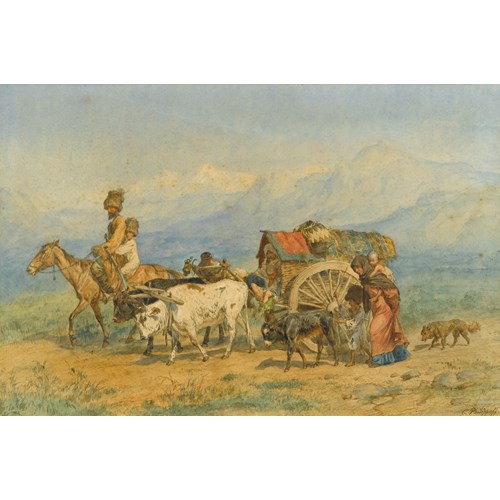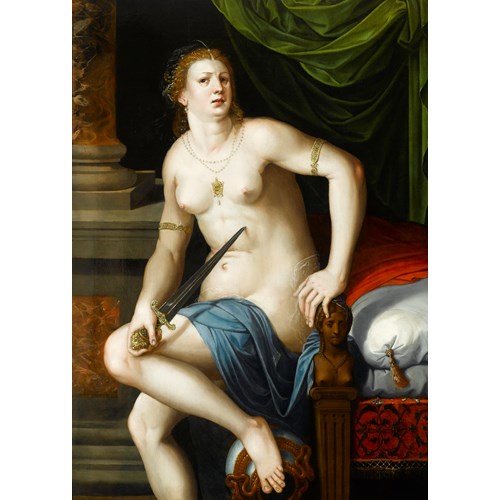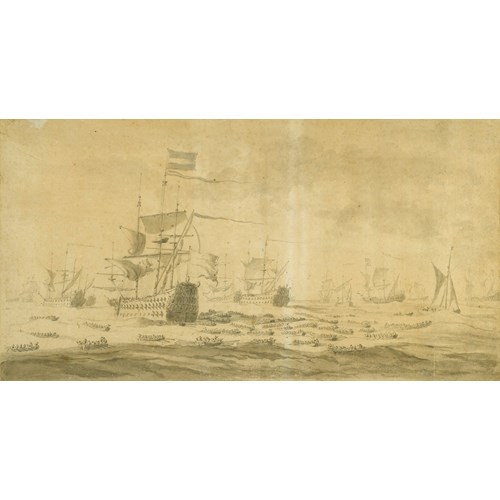Christoph Schwarz
The Raising of Lazarus
Period 1400-1600, 16th Century
Origin Germany
Medium Red chalk, Pen, Brown wash
Dimension 41.2 x 106.5 cm (16¹/₄ x 41⁷/₈ inches)
This drawing, attributed to Chrisoph Schwarz, shows Lazarus being gently lifted up from his tomb by two onlookers. The acute precision of the pen and ink technique and the artist’s employment of a muted wash, establishes a skilful contrast between light and shade as the limbs of the various figures are carefully accentuated. The sisters of Lazarus can be seen, one flanks Jesus, who is made clearly identifiable by the halo above his head, and the other sister stands immediately behind him. Anxiously whispered conversations take place amongst members of the crowd as they stand in awe at the miracle taking place before them.
The present drawing represents a study for a tomb dated 1598 in the Church of St. Anne, Augsburg. A drawing of the same composition, also attributed to Schwarz, is in the Narodwe Museum, Warsaw, and a copy is in the Staatsgalerie, Stuttgart.²,³
Schwarz was a pupil of Hans Bocksberger II in Munich for six years from c.1560. When he subsequently travelled to Italy, he spent the majority of his time in Venice, where he became a pupil of Titian (c.1485/90-1576). On his return to Germany, he was appointed court painter to Duke Albert IV, a post which he held until his death in 1592. He was responsible for decorating several public buildings in Munich including the Senger Brewery in Burgstrasse and a merchant’s house at Kauffingerstrasse 4. During the reign of William V, however, Schwarz focused more closely on smaller devotional images and became the Bavarian court’s favoured painter. He was also commissioned to decorate the interior of the Duchess’ private oratory at the Residenz in Munich. Drawing on his exposure to Venetian artistic techniques, Schwarz used canvas panels to create the ceiling pictures.
In 1585, Schwarz visited Augsburg where he painted the altarpieces of chapels in S.S. Ulrich und Afra and as a result of his great reputation, Emperor Rudolf II attempted to poach him to work in his own court. William V refused but Schwarz was permitted to work in Munich on pieces for Rudolf’s Kunstkammer in Prague - several pictures by him are mentioned in early inventories.
A number of Schwarz’s works were engraved by Jan Sadeler (1550-1600), examples of which can be seen in the Fitzwilliam Museum, Cambridge. Aegidius Sadeler II (?1588-1665) and Lucas Kilian (1579-1637), among others, ensured that the reputation which Schwarz had enjoyed during his lifetime was perpetuated into the eighteenth century. He exerted considerable influence on the Bavarian artists who came after him - Hans Krumper (c.1570-1634), Georg Pecham (c.1568-1604) and others. He is primarily remembered as one of the main practitioners of the Venetian manner in south German painting, making him a forerunner of the Baroque style of Johann Rottenhammer the Elder (1564-1625).
¹ John 11.25-26.
² inv. no. 5987.
³ For other drawings by Christoph Schwarz see Zeichnung in Deutschland. Deutsche Zeichner 1540 - 1640, exhib. cat., Stuttgart, Staatsgalerie, 1979-80, nos. D9-12.
Period: 1400-1600, 16th Century
Origin: Germany
Medium: Red chalk, Pen, Brown wash
Signature: Numbered ‘24’ and with inscriptions ‘B’ and ‘Marto Wi...’ (verso).
Dimension: 41.2 x 106.5 cm (16¹/₄ x 41⁷/₈ inches)
Provenance: Anonymous sale, Sotheby’s, Amsterdam, 1 December 1986, lot 9 (as Matthias Kager);
Lodewijk Houthakker (1926-2008), his mark (Lugt. 3893);
with Hazlitt, Gooden and Fox, London, 1993, no. 17 (as Matthias Kager);
Niall Hobhouse.
Literature: P. Fuhring, Design into Art: drawings for architecture and ornament, the Lodewijk Houthakker Collection, I, London, 1989, p. 243, no. 275 (as Matthias Kager).
More artworks from the Gallery









